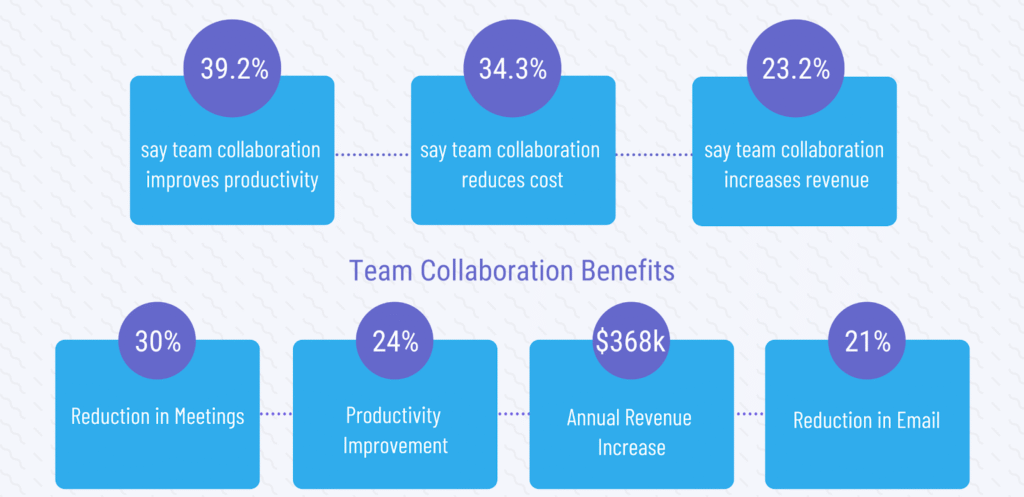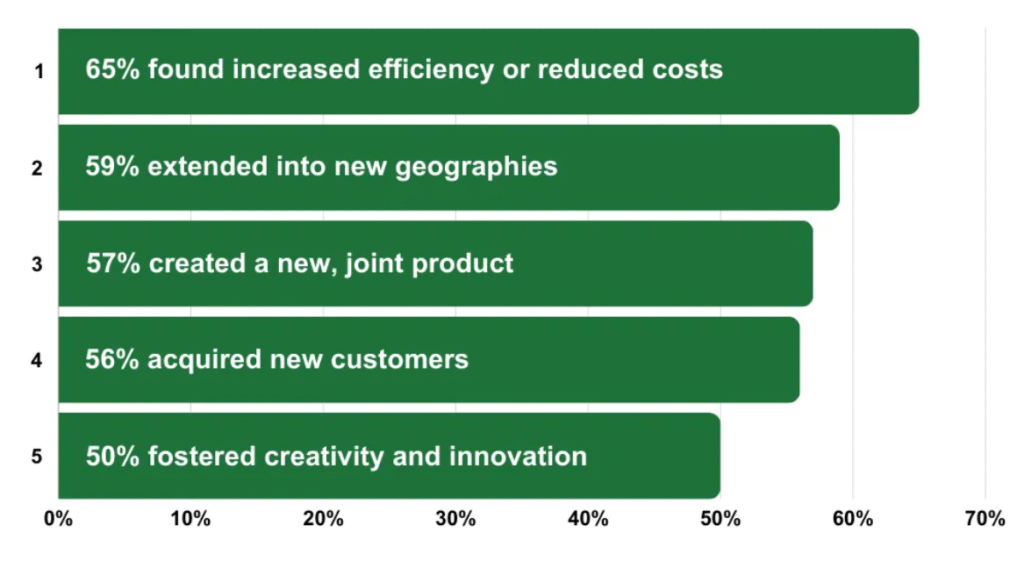Collaboration is the backbone of organisational success, enabling teams to leverage diverse expertise, accelerate decision-making, and adapt to complex challenges. However, many organisations struggle with silos—departmental or functional barriers that restrict information flow and hinder teamwork. Silos often emerge organically as organisations grow, but their persistence can stifle creativity, slow processes, and create friction among teams.

Source: ProofHub
In a 2023 global survey, 76% of executives reported that silos negatively impacted productivity, while 68% linked poor collaboration to missed revenue opportunities. Silos fragment communication, duplicate efforts, and erode trust, ultimately undermining organisational success. However, by prioritising communication, shared goals, and integrated systems, organisations can transform fragmented teams into cohesive units that drive innovation and performance.
2. Understanding Silos: Causes and Consequences
2.1 What Are Silos?
Silos refer to isolated teams or departments that operate independently, with limited communication or coordination with others. While silos may initially form to streamline focus, they often become rigid, impeding collaboration and organisational agility.
2.2 Causes of Silos
Silos arise from structural, cultural, and operational factors, including:
- Organisational Structure: Hierarchical or overly specialised structures can isolate teams, as departments prioritise their own goals over collective ones.
- Leadership Practices: Leaders who incentivise competition over cooperation reinforce silos, fostering territorial behaviors.
- Communication Gaps: Ineffective communication channels—whether due to outdated tools or unclear protocols—limit information sharing.
- Cultural Misalignment: Divergent team cultures or lack of shared values create mistrust, reducing willingness to collaborate.
- Technology Fragmentation: Disconnected systems, such as separate CRMs or project management tools, restrict data access across teams.
2.3 Consequences of Silos
Silos have far-reaching impacts on organisational performance:
- Reduced Efficiency: Duplicated efforts and misaligned priorities waste time and resources. For instance, marketing and sales teams working independently may target the same customers with conflicting messages.
- Stifled Innovation: Lack of cross-pollination limits idea-sharing, slowing product development or process improvements. In addition to this, incomplete information due to restricted communication tends to lead to suboptimal choices.
- Employee Disengagement: According to research by LSA Global, 68% of companies lacking organisational alignment report low levels of engagement. Silos create frustration, as team members feel disconnected from broader goals, lowering morale and retention.
- Financial Costs: Inefficiencies and missed opportunities translate to lost revenue and higher operational costs.
3. The Case for Synergy

Source: Metrigy
Synergy occurs when teams work cohesively, leveraging collective strengths to achieve outcomes greater than the sum of individual efforts. Achieving synergy requires dismantling silos and building systems, processes, and cultures that prioritise teamwork over isolation.
Collaborative teams:
- Enhance Innovation: A Deloitte study found that 73% of employees who engage in collaborative work report improved performance, while 60% say it sparks their innovation. Diverse perspectives spark creativity, leading to breakthrough solutions.
- Boost Efficiency: Studies reveal that 64% of employees waste at least three hours a week due to collaboration inefficiencies, with 20% losing up to six hours. Shared resources and streamlined processes reduce redundancy.
- Improve Agility: Cross-functional alignment enables faster responses to market changes.
- Strengthen Culture: Collaboration fosters trust and inclusion, enhancing employee satisfaction.
- Drive Sales and Customer Value: Teamwork increases sales by 27%, according to a study showing the impact of collaboration on revenue generation. Also, unified teams deliver seamless experiences, strengthening brand loyalty.
4. Strategies for Breaking Down Silos
To transition from silos to synergy, organisations must address structural, cultural, and technological barriers. The following strategies provide a comprehensive approach to aligning teams.
4.1 Align on Shared Goals and Vision
McKinsey found in a study that teams aligned with a shared vision are 1.9 times more likely to surpass financial goals. A unified purpose bridges departmental divides, ensuring teams work toward common objectives. Organisations need a unifying vision and mission, which should be communicated regularly through town halls, newsletters, and leadership messaging to maintain alignment.
Alignment on goals involves establishing overarching priorities, such as increasing market share or improving customer satisfaction, that require cross-team collaboration. These high-level objectives can then be translated into team-specific targets that emphasise interdependence. For example, marketing and product teams might share a goal of launching a customer-centric feature.
4.2 Foster Open Communication
According to a Microsoft survey, 96% of decision-makers and 95% of employees identify communication as crucial for workplace success. Effective communication dismantles barriers and builds trust across teams by fostering transparency, collaboration, and shared understanding. Organisations can strengthen this foundation by establishing cross-functional forums—such as innovation councils or project syncs—where teams regularly share updates, align on goals, and address challenges.
Leveraging collaboration tools like Slack, Microsoft Teams, or Notion centralises communication and ensures real-time access to critical information. To bridge gaps, particularly in diverse or remote environments, companies should also invest in training programs that focus on active listening, conflict resolution, and cross-cultural communication.
4.3 Redesign Organisational Structure
Structural changes can effectively reduce organisational silos by fostering greater integration and collaboration across teams. One approach is to adopt cross-functional teams—either temporarily or permanently—bringing together members from different departments to work on specific projects like product launches or process improvements.
Flattening hierarchies by reducing layers of management can further empower employees, accelerate decision-making, and enhance responsiveness, while still maintaining clear reporting lines. Redefining roles to include cross-departmental responsibilities also encourages individuals to collaborate beyond their immediate teams.
4.4 Build a Collaborative Culture
A recent survey showed that 41% of employees are considering leaving their jobs due to poor collaboration at work. Culture plays a pivotal role in shaping behaviour, making it a powerful lever for breaking down silos and promoting collaboration. Building a culture of trust and inclusion is essential—creating psychological safety where team members feel valued and confident sharing ideas without fear of criticism.
Encouraging collaboration can be further reinforced by aligning performance metrics and incentives with team-based outcomes rather than individual achievements. Celebrating collective wins through internal communications helps highlight the impact of cross-team efforts and reinforces the value of working together.
4.5 Integrate Technology and Data
Technology can be a powerful unifier, enabling seamless information sharing and collaboration across teams. Centralising data through shared platforms like enterprise resource planning (ERP) or customer relationship management (CRM) systems creates a single source of truth, improving consistency and visibility.

Source: ProofHub
Standardising tools across departments further reduces friction and ensures compatibility, streamlining workflows. Cloud-based solutions enhance accessibility, allowing remote and global teams to access real-time data from anywhere. To maximise the impact of these tools, organisations should provide ongoing training that supports effective adoption and minimises resistance to new systems.
4.6 Empower Leadership to Drive Change
According to a study by Alludo, 78% of employees say their company leadership is not doing enough to promote collaboration within the organisation. Leaders play a pivotal role in dismantling silos by setting the tone for collaboration and driving cross-functional alignment. By modeling collaborative behaviour and actively engaging with peers across departments, leaders demonstrate the value of teamwork.
Investing in leadership development through training in change management, emotional intelligence, and cross-functional coordination equips leaders with the skills needed to navigate complexity and foster integration. To ensure a lasting impact, it’s essential to hold leaders accountable by tracking progress on collaboration initiatives and addressing resistance proactively.
5. Conclusion
A survey by the World Economic Forum asked business leaders what benefits they experienced from collaborative ecosystems. It was found that a collaborative workplace attributed to, on average, 13.7% of total annual revenues, 12.9% in cost reduction, and 13.3% in incremental earnings. This survey and many others like it highlight the importance of collaboration and synergy within teams in an organisation.
Advantages of Collaboration and Synergy

Source: B2B Review
Silos are a pervasive challenge, but they are not insurmountable. By moving from silos to synergy, organisations can unlock the full potential of their teams, fostering innovation, efficiency, and resilience. This resource outlines a comprehensive approach to aligning teams through shared goals, open communication, structural redesign, collaborative culture, integrated technology, and empowered leadership. By following the described framework, organisations can dismantle barriers, build trust, and create a culture where collaboration thrives. In an era of complexity and competition, synergy is not just an advantage—it’s a necessity for sustained success.
How Proten International Can Help
Organisations must act decisively to break down silos and foster synergy, and Proten International can help with that. You need the right partner to help assess your teams’ collaboration gaps, engage employees in co-creating solutions, introduce the most suitable tools, and provide training to support full integration. Contact us today, and we will help transform your fragmented teams into powerful drivers of innovation and growth, positioning your organisation for success in a connected world.

